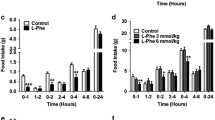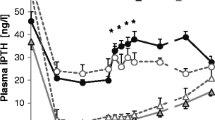Abstract
Summary
In 17 adults on a fixed metabolic diet, an 11-day course of cinacalcet increased serum gastrin and basal gastric acid output, but not maximal gastric acid output, compared with a placebo. These findings indicate that the calcium sensor receptor plays a role in the regulation of gastric acid.
Introduction
Gastric acid secretion is a complex process regulated by neuronal and hormonal pathways. Ex vivo studies in human gastric tissues indicate that the calcium sensing receptor (CaR), expressed on the surface of G and parietal cells, may be involved in this regulation. We sought to determine whether cinacalcet, a CaR allosteric agonist, increases serum gastrin and gastric acid secretion.
Methods
Seventeen healthy adults with normal gastric acid output were placed on an 18-day metabolic diet. On day 8 (baseline), participants were given cinacalcet (15 then 30 mg/day) or placebo for 11 days. Changes in gastric acid output, serum gastrin, and other measures were compared in the two groups.
Results
Changes in serum gastrin and basal acid output (adjusted for baseline body weight) were significantly more positive in the cinacalcet group compared with placebo (P = 0.004 and P = 0.039 respectively). Change in maximal acid output was similar in the two groups (P = 0.995). As expected, cinacalcet produced significant decreases in serum PTH (P < 0.001) and ionized calcium levels (P = 0.032), and increases in serum phosphorus levels (P = 0.001) and urinary calcium (P = 0.023).
Conclusions
This study provides in vivo evidence that activation of the CaR increases serum gastrin levels and basal gastric acid secretion in healthy adults.

Similar content being viewed by others
References
Reeder DD, Conlee JL, Thompson JC (1971) Calcium carbonate antacid and serum gastrin concentration in duodenal ulcer. Surg Forum 22:308–310
Levant JA, Walsh JH, Isenberg JI (1973) Stimulation of gastric secretion and gastrin release by single oral doses of calcium carbonate in man. N Engl J Med 289:555–558
Barreras RF, Donaldson RM Jr (1967) Effects of induced hypercalcemia on human gastric secretion. Gastroenterology 52:670–675
Fordtran J (1968) Acid rebound. N Engl J Med 279:900–905
Barreras RF (1970) Acid secretion after calcium carbonate in patients with duodenal ulcer. N Engl J Med 282:1402–1405
Behar J, Hitchings M, Smyth RD (1977) Calcium stimulation of gastrin and gastric acid secretion: effect of small doses of calcium carbonate. Gut 18:442–448
Brown EM, Gamba G, Riccardi D et al (1993) Cloning and characterization of an extracellular Ca(2+)-sensing receptor from bovine parathyroid. Nature 366:575–580
Ray JM, Squires PE, Curtis SB, Meloche MR, Buchan AM (1997) Expression of the calcium-sensing receptor on human antral gastrin cells in culture. J Clin Invest 99:2328–2333
Buchan AM, Squires PE, Ring M, Meloche RM (2001) Mechanism of action of the calcium-sensing receptor in human antral gastrin cells [see comment]. Gastroenterology 120:1128–1139
Dufner MM, Kirchhoff P, Remy C et al (2005) The calcium-sensing receptor acts as a modulator of gastric acid secretion in freshly isolated human gastric glands. Am J Physiol 289:G1084–G1090
Nemeth EF (2004) Calcimimetic and calcilytic drugs: just for parathyroid cells? Cell Calcium 35:283–289
Igarashi T, Ogata E, Maruyama K, Fukuda T (2000) Effect of calcimimetic agent, KRN568, on gastrin secretion in healthy subjects. Endocr J 47:517–523
Brown EM, Hebert SC (1997) Calcium-receptor-regulated parathyroid and renal function. Bone 20:303–309
Chernecky CC, Berger BJ (eds) (1997) Laboratory tests and diagnostic procedures. Saunders, Philadelphia
Wolfe MM, Soll AH (1988) The physiology of gastric acid secretion. N Engl J Med 319:1707–1715
Hersey SJ, Sachs G (1995) Gastric acid secretion. Physiol Rev 75:155–189
Geibel JP, Wagner CA, Caroppo R et al (2001) The stomach divalent ion-sensing receptor scar is a modulator of gastric acid secretion. J Biol Chem 276:39549–39552
Waldum HL, Brenna E, Sandvik AK (1998) Relationship of ECL cells and gastric neoplasia. Yale J Biol Med 71:325–335
Waldum HL, Arnestad JS, Brenna E, Eide I, Syversen U, Sandvik AK (1996) Marked increase in gastric acid secretory capacity after omeprazole treatment. Gut 39:649–653
Recker RR (1985) Calcium absorption and achlorhydria. N Engl J Med 313:70–73
Wood RJ, Serfaty-Lacrosniere C (1992) Gastric acidity, atrophic gastritis, and calcium absorption. Nutr Rev 50:33–40
O’Connell MB, Madden DM, Murray AM, Heaney RP, Kerzner LJ (2005) Effects of proton pump inhibitors on calcium carbonate absorption in women: a randomized crossover trial. Am J Med 118:778–781
Goodman WG, Hladik GA, Turner SA et al (2002) The calcimimetic agent AMG 073 lowers plasma parathyroid hormone levels in hemodialysis patients with secondary hyperparathyroidism. J Am Soc Nephrol 13:1017–1024
Shoback DM, Bilezikian JP, Turner SA, McCary LC, Guo MD, Peacock M (2003) The calcimimetic cinacalcet normalizes serum calcium in subjects with primary hyperparathyroidism. J Clin Endocrinol Metab 88:5644–5649
Favus MJ (ed) (2006) Primer on the metabolic bone diseases and disorders of mineral metabolism. American Society for Bone and Mineral Research, Washington, DC
Conigrave AD, Lok HC (2004) Activation of renal calcium and water excretion by novel physiological and pharmacological activators of the calcium-sensing receptor. Clin Exp Pharmacol Phys 31:368–371
Peacock M, Bilezikian JP, Klassen PS, Guo MD, Turner SA, Shoback D (2005) Cinacalcet hydrochloride maintains long-term normocalcemia in patients with primary hyperparathyroidism. J Clin Endocrinol Metab 90:135–141
Silverberg SJ, Bone HG III, Marriott TB et al (1997) Short-term inhibition of parathyroid hormone secretion by a calcium-receptor agonist in patients with primary hyperparathyroidism. N Engl J Med 337:1506–1510
Rude RK (1998) Magnesium deficiency: a cause of heterogeneous disease in humans. J Bone Miner Res 13:749–758
Djurhuus MS, Gram J, Petersen PH, Klitgaard NAH, Bollerslev J, Becknielsen H (1995) Biological variation of serum and urinary magnesium in apparently healthy males. Scand J Clin Lab Invest 55:549–558
Martini LA, Wood RJ (2001) Assessing magnesium status: a persisting problem. Nutr Clin Care 4:332–337
Gaginella TS (ed) (1996) Handbook of methods in gastrointestinal pharmacology. CRC, Boca Raton
Block GA, Martin KJ, de Francisco AL et al (2004) Cinacalcet for secondary hyperparathyroidism in patients receiving hemodialysis. N Engl J Med 350:1516–1525
Dong BJ (2005) Cinacalcet: an oral calcimimetic agent for the management of hyperparathyroidism. Clin Ther 27:1725–1751
Acknowledgements
We are grateful to the staff of the Metabolic Research Unit at the Jean Mayer USDA HNRCA at Tufts University for assistance in carrying out on this study. LC, SSH, HMR, and BD-H contributed to the design, analysis, and writing of the manuscript. BD-H obtained the funding. LC was supported by the Dr. Gerald J. and Dorothy R. Friedman New York Foundation for Medical Research Grant and a National Institutes of Health Institutional Research Training grant T32 DK007651–16.
Conflicts of interest
None.
Author information
Authors and Affiliations
Corresponding author
Additional information
Clinical Trial: NCT00336739
This material is based upon work supported by the US Department of Agriculture, Agricultural Research Service, under agreement No. 58–1950–7–707. Any opinions, findings, conclusion, or recommendations expressed in this publication are those of the author(s) and do not necessarily reflect the view of the US Dept of Agriculture.
Rights and permissions
About this article
Cite this article
Ceglia, L., Harris, S.S., Rasmussen, H.M. et al. Activation of the calcium sensing receptor stimulates gastrin and gastric acid secretion in healthy participants. Osteoporos Int 20, 71–78 (2009). https://doi.org/10.1007/s00198-008-0637-8
Received:
Accepted:
Published:
Issue Date:
DOI: https://doi.org/10.1007/s00198-008-0637-8




